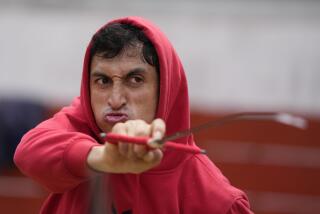A Spanish bullfighter is gored--what affects risk-taking behavior?
- Share via
A Spanish bullfighter was badly gored last week, the Associated Press reports, when the bull he was fighting rammed its left horn into his lower jaw, making his eyeball protrude.
After being gored, 39-year-old bullfighter Juan Jose Padilla stood up, blood gushing from his face, and was helped from the arena. After a five-hour operation he may be left with facial paralysis and blindness in one eye.
While Internet commenters are busy arguing the pros and cons of bullfighting (we’ll let you guess which side 99% of the comments are on), we were interested in the psychology behind risk-taking behavior. While bullfighting has a storied history in Spain and other countries, not everyone is up for going into a ring with an angry animal that weighs about 1,300 pounds.
Before we explore studies that lend some insight into the psychology of risk-taking behavior, let’s start with some statistics. A 2006 study in the Journal of Trauma examined bullfighting injuries in Guadalajara, Mexico, between 1994 and 2004.
Out of 750 bullfighters, 68, or about 9%, required some emergency help during the bullfight. The most common injuries were trauma to the upper and lower extremities (66%), followed by injuries to the groin (8%) and the perineal area (7%). More extreme wounds included penetrating injuries that required surgery to remove dead tissue and debris in 64% of cases. Closed fractures made up 4% of cases and major vascular injuries made up 5% of cases. The authors wrote, “A considerable risk of serious, life-threatening injuries is inherent to bullfighting.”
Taking risks and being injured may be related to how those risks are perceived. In one 2004 study in the Journal of Pediatric Psychology 260 male and female soccer players age 11 to 14 were asked how likely it was they’d be injured while playing soccer. They were also asked how often they’d take part in nine risk-taking behaviors in soccer, and they estimated their playing ability.
Researchers discovered that risk factors for being injured were having a low perceived risk of the sport and a low assessment of their own ability. On the flip side, having a high perceived risk of the game and a similar high estimation of skill protected players against injury. In general, girls did less risk taking than boys.
Another study in 2011 in the journal Psychological Bulletin showed there may be a link between watching media that glorify risk-taking and actually taking those risks. A meta-analysis of studies from 1983 and 2009 that included more than 80,000 participants found that playing video games that depicted risky behavior positively was more apt to trigger that behavior compared with taking part in more passive entertainment such as listening to music or watching a movie.
A 2010 study in the British Journal of Sports Medicine found that among skiers, risk-taking behavior is linked with being younger, being a better skier, being male, having a lower body mass index and going faster. Helmet use wasn’t associated with taking more risks.
Back to bullfighting: With sentiment against the sport growing, a ban on bullfighting goes into effect this year in the northeast Catalonia region of Spain.






